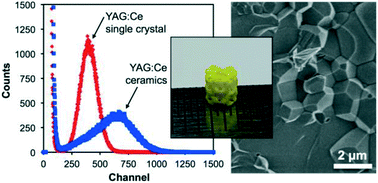Inorganic scintillators have desirable properties for the detection of ionising radiation,with potential applications including in nuclear instrumentation. Scintillators are materials which produce light when they interact with ionising radiation allowing the radiation to be detected and quantified. However,the methods used to prepare inorganic scintillators are a limitation to the development of further uses. Growing crystals from the melt provides only a limited range of materials and,while glasses or glass-ceramics allow a wider range,these materials typically have a low light intensity. Polycrystalline ceramics lie between single crystals and glasses in terms of properties.
In a recent paper,Dosovitskiyet al.demonstrate the preparation of the scintillator YAG:Ce (yttrium aluminium garnet doped with cerium activator) as a polycrystalline ceramic using 3D-printing.This was achieved for Y2.97Ce0.03Al5O12by co-precipitation followed by heating at 900oC. A slurry of the resulting powder was then used to 3D-print green bodies using stereolithography. A so-called green body contains the material of interest along with a binder,the latter being subsequently removed by heating.
After debinding and sintering at 1600oC将所得陶瓷材料的性能与相应的YAG:Ce单晶进行了比较。陶瓷显示出比单晶高出60%以上的闪烁光。when using 5.5 MeV α-particles.
使用这种制备方法可以获得比单晶体更高的活化剂浓度,这有利于光的产生。3D打印允许生产其他方法无法获得的形状,free of defects and larger than 1 micrometer. One possible application of this is in the production of luminescent materials for LED lighting devices.
For more information,see the full paper at:
First 3D-printed complex inorganic polycrystalline scintillator
A.Dosovitskiy,P.V.Karpyuk, P.V.EvdokimovD.E.库兹涅佐娃A.Mechinsky, A.E.Borisevich,A.A.FedorovV.I.Putlayev,A.E.Dosovitskiy,MV.Korjik
DOI:10.1039/C7CE00541E
__________________________________________________
 Gwenda Kyd has a PhD in metallocarborane 新利手机客户端chemistry from the University of Edinburgh.Other research work includes the spectroscopic study of the structure of glasses and organometallic electron-transfer reactions and the preparation of new inorganic phosphors.She published a book,‘Molecules,Medicines and Mischief',2014,关于在植物中发现的一些化学物质,目前正在进行后续工作。
Gwenda Kyd has a PhD in metallocarborane 新利手机客户端chemistry from the University of Edinburgh.Other research work includes the spectroscopic study of the structure of glasses and organometallic electron-transfer reactions and the preparation of new inorganic phosphors.She published a book,‘Molecules,Medicines and Mischief',2014,关于在植物中发现的一些化学物质,目前正在进行后续工作。












I am not very technical but since i work in 3D printing service industry i can say complex shapes can easily be formed in high precision with 3D printing and i believe this certainly is a big advantage.